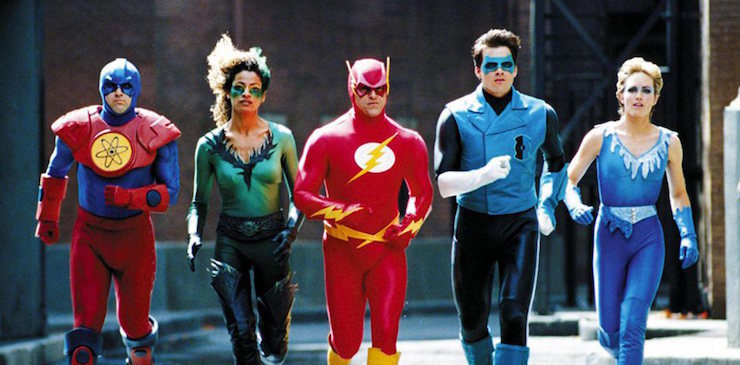DC Comics rebooted and/or revitalized many of their superheroes throughout the late 1950s, and when that had proven successful, Julius Schwartz and Gardner Fox then provided a new version of the Justice Society of America, now called the Justice League of America, in 1960, which brought all those heroes together in a single team book.
Stan Lee and Jack Kirby created the X-Men in 1963 to serve two needs: provide an easy out for origin stories by creating mutants—people born with powers—and also do a school for superheroes where they learn about their powers in an academic environment.
Over the years, both the Justice League and the X-Men went through numerous permutations—and also subsidiary teams. In the latter case, in 1982 Chris Claremont and Bob McLeod created a new team of mutant students. The X-Men at that point had moved far past the school notion, so the New Mutants were created. In 1994, Scott Lobdell and Chris Bachalo created Generation X, which was also a team of mutants learning how to control their powers.
Both teams had TV movies intended as series pilots aired in the 1990s, though Justice League of America never actually aired. Neither went to series.
Looking back in cynicism, it seems as if Generation X was only created with a new name so that Lobdell and Bachalo could get credit as creators. The concept was exactly the same as New Mutants, the only difference being that they were at the Massachusetts Academy instead of the Xavier Institute—and the MassAc was established as a rival school to Xavier’s way back in New Mutants.
In any case, GenX was created at a time when the X-books were going strong. With the New Mutants having mutated (ahem) into X-Force, a new book focusing on teens learning how to handle their powers was created as part of the “Phalanx Covenant” multibook storyline, one of the near-infinite numbers of multibook storylines the X-books did in the 1990s. Then the Generation X comic ran until 2001, and was recently resurrected (ahem) as part of the ResurrXion storyline.
Marvel also spent the ’90s trying to get their comics adapted for the screen. We dealt with two particularly impressive failures last week, and this go-round on television didn’t do any better, as it suffered poor ratings and poorer reviews and didn’t go to series.
The Justice League has gone through many iterations over the decades. While initially a team-up of DC’s most popular heroes, the roster constantly changed and evolved and shifted. During the 1980s, following the Legends miniseries, a new Justice League series was started, written by Keith Giffen & J.M. DeMatteis, with art by Kevin Maguire. The book was light-hearted to say the least, and quickly became more so as readers responded to the silliness.
Giffen & DeMatteis left the book in 1992, but its popularity lived on. They returned to the League with the 2003 miniseries Formerly Known as the Justice League.
The 1997 TV pilot, which never aired in the U.S. (though it inexplicably got airings in various foreign markets), was inspired by the Giffen/DeMatteis roster (the Guy Gardner version of Green Lantern, Fire and Ice, the Martian Manhunter), at least in part because the rights to those characters were more readily available than the heavy hitters at DC (Superman, Batman, Wonder Woman). They also went for a more comic tone, akin to that era of the comic book, and also inspired by popular contemporary sitcoms like Friends and Seinfeld.
“For an over-sexed mind witch, you really are a tightass”
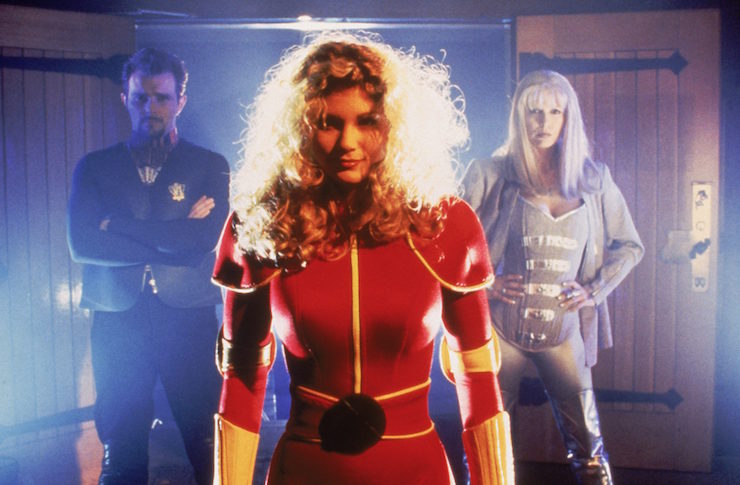
Generation X
Written by Eric Blakeney
Directed by Jack Sholder
Produced by Bruce Sallan & Eric Blakeney
Original release date: February 20, 1996
Emma Frost and Russell Tresh are scientists who are part of a government project that is trying to access the dream dimension—it’s the dimension where the mind goes when it dreams. Mutants have better ability to access the dream dimension, and Tresh decides to experiment on a live mutant by removing living brain fluid. Frost stops him, but in the end the mutant test subject is arrested for being unregistered and is sent to Mutant Camp. Tresh is not arrested, but is fired. Outraged that the victim has been arrested while the perpetrator goes free, Frost—a powerful telepathic mutant—quits as well.
Five years later, Tresh has partnered with a businessman named Bobby Raltson. Tresh has pioneered a method of subliminal advertising that has made both Tresh and Ralston a great deal of money in several industries, including videogames. Tresh, though, wants to actually enter people’s dreams and plant suggestions into their minds that they can’t resist. Ralston is dubious about this, and urges Tresh to stick with the subliminal stuff when they plead with the board for more funding, as the board won’t go for the whole out-there dream-dimension stuff.
A teenager named Jubilation Lee is playing a videogame when her mutant powers are set off. She can shoot fireworks from her fingertips. She’s arrested, and her parents are told she’s going to be sent to Mutant Camp.
Frost shows up along with Sean Cassidy, also a mutant who has a sonic scream. They run Xavier’s School for Gifted Youngsters, a school for mutants, and they recruit “Jubilee” for their school as a better alternative to Mutant Camp. They drive Jubilee back to the school, along with Angelo Espinoza, a mutant whose skin can stretch, which gets him the nickname “Skin.”
They arrive at Xavier’s and meet the other four students: Kurt Pastorious, a.k.a “Refrax,” whose eyes emit radiation, including X-rays and heat beams; “Mondo,” who can make his skin be the consistency of anything he touches; Arlee Hicks, a.k.a. “Buff,” who is super-strong and muscular (her self-consciousness about the latter leads to her wearing bulky clothes all the time); and Monet St. Croix, who is brilliant, strong, and invulnerable—and also with a serious attitude problem.
Frost and Cassidy teach them regular school classes, as well as training in the school’s security system, and in how to access their dreams. (At no point do we ever see them being trained in how to actually use their powers.)
They go into town and have a bonding afternoon of shopping and such. Skin is attracted to a blonde girl named Kayla, and he follows her around kinda creepily. Kayla’s friends decide to haze him a bit, shoving his face into a banana split.
Tresh ignores Ralston’s advice and presents his dream-entering tech to the board. To demonstrate its efficacy, the night before, he entered all their dreams and ordered them to have gastric distress at ten o’clock the next morning. Sure enough, when the clock strikes ten, they all fart.
Perhaps not surprisingly, this doesn’t make the board eager to embrace this technology, which crosses the line into mind control. Ralston is tasked with dealing with Tresh, but Tresh beats him to the punch by invading his dream and getting him to commit suicide.
When playing around with the security computer, Skin discovers the dream machine that Frost and Tresh had been working on for the government, which Frost keeps locked in the basement. He and Jubilee decide to use it, and both of them are visited in their dreams by Tresh. (Tresh recognizes Jubilee from the arcade where she was arrested—he’d been checking on the subliminal ads in the video games—and Jubilee recognizes him from the subliminal message, which mutants can see overtly.) Jubilee is creeped out by Tresh, but Skin doesn’t think he’s that bad, especially when Tresh offers to help him talk to Kayla through her dreams, which is totally creepy.
The cops find Tresh in his dream machine while investigating Ralston’s death, and they remove him from it forcibly, which almost casts Tresh’s mind into the abyss, but Skin is able to use his stretchy abilities to grab Tresh’s dream self and pull him back. While that saves Tresh’s mind from being destroyed, he can’t actually get back into his body, so he’s trapped in the dream dimension while his comatose body is in a medium-security hospital.
The kids go to a carnival. Skin and Kayla find each other and hang out, while Refrax hits on Buff. Both couples are screwed over, the former by Kayla’s friends starting a brawl, the latter by Refrax’s powers kicking in unexpectedly and allowing him to see through Buff’s clothes, which freaks him out.
Frost and Cassidy get the kids out of jail after the brawl, and Frost decides to expel Skin for starting the fight. But all the other kids show solidarity with him, and Cassidy gets Frost to back off the expulsion, instead just grounding them for a month. (Frost and Cassidy have a heart-to-heart, where we learn that Frost had a previous group of students known as the Hellions, who all died.)
Skin uses the dream machine to see Kayla in her dreams, since being grounded keeps him from seeing her in reality. Then Tresh shows up in his dream and asks him to free his body by bringing the dream machine to the hospital. Skin reluctantly does so, and then Tresh kidnaps him, intending to finish the experiment he started five years earlier.
Tresh hooks Skin up to the dream machine to try to harvest his mutant ability to access the dream dimension, but Skin is able to get a message through to a dreaming Jubilee. She gathers the team, and Frost and Cassidy lead them to attack Tresh.
Frost is able to send them all to the dream dimension, but in order to do so in such a way that Tresh doesn’t realize it, she needs all her focus, so she won’t be able to help the kids in any other way. Cassidy and the rest of the team attack Tresh, who rebuffs their attacks with remarkable ease given his lack of super-powers. However, he then seems to gain powers. Frost creates a doorway out for the others, and she is ready to sacrifice herself by tossing herself and Tresh into the abyss to destroy both their minds. However, Skin beats her to it, wrapping his arms around Tresh (multiple times) and diving into the abyss.
The others are devastated, thinking they lost him, but then he uses a stretchy arm to pull himself back. Refrax apologizes to Buff for freaking out, and Frost and Cassidy show off the new uniforms they’ll be wearing—starting with Buff, who actually wears her skintight outfit, showing off her musculature. Meanwhile, Tresh is back in a coma, back in the hospital.
“Software salesmen don’t have emergencies, Guy”
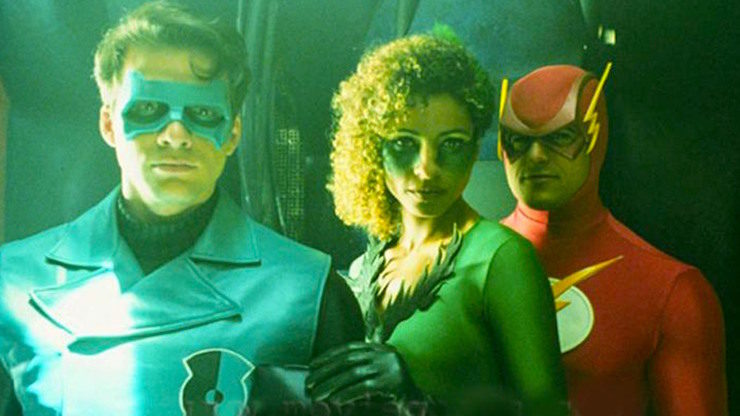
Justice League of America
Written by Lorne Cameron & David Hoselton
Directed by Félix Enríquez Alcalá
Produced by Larry Rapaport
Never officially released
A terrorist who calls himself the Weatherman has a weather manipulator, and is using it to blackmail the city of New Metro. The Eno Meteorological Institute is tracking the hurricane, and we meet three people there: Dr. Eno, who runs the joint, as well as two of his meteorologists, Tora Olafsdottir and Arliss Hopke. Hopke keeps trying and failing to get Eno to look at a new project of his, while Olafsdottir simply gets tongue-tied around the boss.
With the hurricane hitting, the first one in New Metro history, the Justice League of America moves into action. Professor Ray Palmer cuts his science class short, B.B. DaCosta has to walk out of an audition, Guy Gardner interrupts a date—itself a make-good for a previously interrupted date—and Barry Allen leaves in the midst of getting evicted from his apartment. They change into, respectively, the Atom, Fire, Green Lantern, and the Flash. While the first three save several people (and also one cat), the Flash uses his super-speed to dissipate the hurricane.
As they change back into civvies, Allen says he’s lost his job and been evicted. Palmer and Gardner reluctantly let him move in with them. DaCosta returns to the audition, but it’s over—however the kid who cleans the place, Martin, hits on her, despite still not being of drinking age. DaCosta tries to let him down easy.
Olafsdottir is working late one night when she stumbles across a weird device that she accidentally spills liquid onto. It sparks and covers her in smoke, and then after that, she finds herself able to freeze anything. (She somewhat accidentally saves someone from drowning while walking home.)
The Justice League kidnaps Olafsdottir from her home but do not reveal themselves. Their leader, J’onn J’onzz, is soon satisfied that she is not the Weatherman and they return her to her bed where she’s convinced it was all a bad dream.
J’onzz is a shape-changer, and he poses as Eno in order to query Olafsdottir about who she thinks might be suspicious in the company. She mentions Hopke, but the League checks Hopke out, and it turns out that he’s simply created a better weather forecaster.
The Weatherman attacks the city with a hailstorm, and once again the League saves the day, though it interrupts another one of Gardner’s dates with Sheila, and she’s pretty much fed up with him. Green Lantern is able to save Sheila from the hailstorm, and she wonders why she can’t meet a guy like GL instead of Gardner, apparently unable to recognize Gardner even though he’s only wearing a domino mask.
Eno is hosting a reception for a senator in the hopes of getting new government funding. Unfortunately, the senator doesn’t make it, though his aide promises to let the senator know what a good party he missed.
The League infiltrates the party. Palmer breaks into an office and checks out the computer files to see what it was that Olafsdottir found that gave her her powers. Gardner is distracted by Sheila being at the party with another man and so he stops guarding the door, thus allowing Olafsdottir—who had been sorta-kinda flirting with Palmer earlier—to catch him. However, she sees that there’s a weather manipulator on the premises that can do everything the Weatherman has done to the city.
Martin continues his pursuit of DaCosta by calling her agent in the guise of a French filmmaker who will cast her in his movie in a few months when he returns from “the continent,” which makes her agent more friendly to her. He also gives her a pair of earrings he got in France that he was saving for someone special.
Olafsdottir sees the Weatherman make another announcement, and she tracks his signal to the roof of the Institute. There she finds Eno talking into a video camera. He’s the Weatherman! She escapes from his clutches by freezing a door.
The League is summoned to stop the Weatherman’s latest attack: a mudslide. Fire is able to stop it, and then she’s interviewed on TV. Martin sees the interview, and that Fire is wearing the earrings he gave DaCosta.
Olafsdottir tracks Palmer down, and he admits that he works for law-enforcement (which he kinda does?), and he promises to do something about Eno. Later, the League in costume bring her to their secret underwater lair, where she more formally meets J’onzz. He explains that he is a refugee from Mars, where his people don’t have the freedoms Americans take for granted. He fights for those freedoms by finding people with super-powers and training them. She says she’ll consider membership.
J’onzz has to disguise himself as Fire and meet Martin alongside DaCosta so the boy will believe that they’re different people, and that DaCosta just lent Fire the earrings. DaCosta gives the earrings back as Martin realizes that she’s not his one true love. (For starters, she just lied to him.) As she and J’onzz leave, the Martian asks, “Don’t your thighs chafe?”
Eno goes to Olafsdottir’s home to convince her that he’s not that bad. She freezes him and takes his weather manipulator. She brings it to JLA HQ, but it turns out that it’s a tracking device that the Weatherman uses to hit the HQ with a laser. The team escapes—except for J’onzz, who insists he can survive the high temperatures—and go after the Weatherman, who is now threatening New Metro with a tidal wave.
Green Lantern fights Eno, but the Weatherman tosses the weather manipulator over a cliff, so they can’t stop the tidal wave with that (though GL does lasso Eno). While Flash, Fire, and the Atom try to save as many people as possible, Olafsdottir manages to freeze the tidal wave.
Eno is arrested, and the four heroes convince Olafsdottir to join the team. DaCosta has even made her a costume, and suggests the codename Ice. She agrees, and also agrees to a lunch date with Palmer, while Allen heads out for his new job as a counselor at a halfway house, Gardner has another date with Sheila, and DaCosta goes off for an audition.
“None of us gifted kids get along”
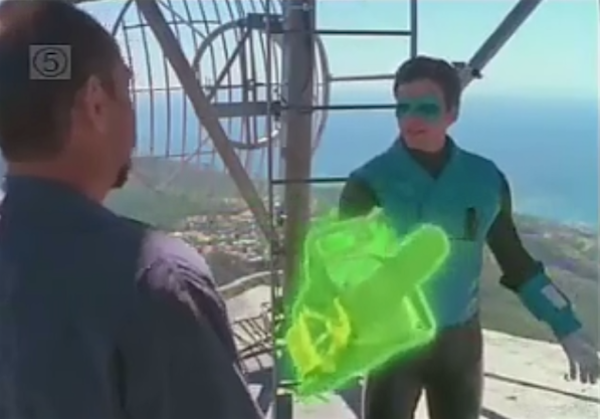
On the face of it, one of the biggest problems with both these movies is their budget, or rather lack of same. When you’re portraying people with super-powers, those powers need to be at least a little bit convincing.
Both Generation X and Justice League of America fail utterly in this regard. They leaned into the issue, for the most part—super-speed is fairly easy to show (and had already been done seven years earlier on the Flash TV series), as are things like Frost’s telepathy, Monet’s super-strength, and Fire and Ice’s abilities to burn and freeze things. Generation X took it a step further by altering two comics characters—Husk, whose skin shed to reveal a tougher epidermis, and Chamber, whose powers blew a hole in his body from the jaw to the stomach—to the more low-budget-friendly Buff (simply super-muscular) and Refrax (simply with vision powers mostly hid behind sunglasses).
But Skin’s stretching doesn’t look any less absurd than Reed Richards’s did in Fantastic Four, Green Lantern’s ring provides only the doofiest of shapes and forms, and both Cassidy’s sonic scream and Atom’s shrinking look patently absurd.
Worst of all, though, is poor David Ogden Stiers slathered in horrendous green makeup and being forced to wear what has always been one of the doofier costumes in comic-dom. They keep Stiers off-camera as much as possible, which is good, as vocally, he’s perfect for the role. Every time J’onzz has been portrayed on screen, he’s been given an actor with a noble, regal voice, from Stiers to Carl Lumbly to Phil Morris to Dorian Harewood to the current version, David Harewood on Supergirl. But physically, the role is a disaster, made worse by the costume accentuating poor Stiers’s huge belly.
The other heroes in JLA don’t fare much better in the costume department. Green Lantern’s outfit is actually okay, but the Atom and Flash and Fire look like kids in bad Hallowe’en costumes (Fire especially), and Atom’s in particular make poor John Kassir look like he weighs three hundred pounds. (Again, there was a Flash TV show just a few years earlier—couldn’t they have taken more of a cue from the outfit John Wesley Shipp wore?)
GenX avoids that problem until the very end when Buff shows up in a very 90s-style X-costume. The characters are otherwise all in street clothes—the only ones who match their comic-book outfits are Frost and Jubilee. The former wears the same white bustiers that the comics character has always favored, while Jubilee is often in her signature yellow raincoat.
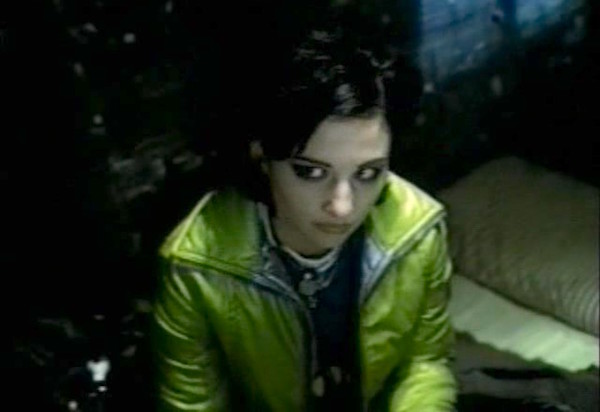
Jubilee is also played by the very-much-not-Asian Heather McComb. The whitewashing of Jubilee was one of the loudest complaints about GenX when it first aired 22 years ago, and it’s 100% deserved. It’s not like there’s a plethora of Asian heroes in the first place, so altering one of the few is pretty crummy. (For that matter, while I think it’s cute that they hired the same actor to play Cassidy who voiced him in the 1990s X-Men cartoon, Jeremy Ratchford’s awful fake Irish accent sounds even worse in live-action, and turns him into a caricature.)
At least GenX spending a lot of time with the characters in their off-time bonding and acting like teenagers is baked into the premise, and provides a handy way to do character development without having to pay for F/X scenes. (And hey, look, it’s a very young Kavan Smith as one of the townies who bothers the kids!) But what the heck were they thinking turning the Justice League into a GenX (ahem) sitcom?
Seriously, the characters are all mangled to fit this odd mode. Green Lantern is a weird combination of Hal Jordan (looks), Kyle Rayner (costume), and Guy Gardner (name), yet doesn’t actually match any iteration of GL, since he’s a software salesman, making you wonder how, exactly, he contrived to get his hands on the ring. (It’s supposed to go to someone who knows no fear; Jordan was a test pilot, John Stewart a Marine, Gardner a football player and teacher. Maybe, like Rayner, he got it by accident…) Atom is inexplicably changed from a renowned scientist to a high-school science teacher, Fire is an aspiring actor, losing the comics character’s espionage background (and the fact that she’s a native of Brazil), and Allen is an unemployed loser instead of a crime-scene investigator. And they spend a tiresome amount of time on personal problems (Allen’s inability to find a career, Gardner’s girlfriend issues, etc.) than they do actually superheroing. And when they do suit up and act heroic, we see very little of it and it’s very badly done. (Seriously, the best GL can do against a normal guy standing on a catwalk is threaten him with a chainsaw? That’s it?)
One of the biggest problems with live-action superheroes is that they often make the notion of disguising yourself with a mask to be ridiculous. It’s particularly ridiculous when a person who knows the civilian ID well meets the superhero. It doesn’t help that, with very rare exceptions (Christopher Reeve being the gold standard; Rex Smith also), the actors rarely do anything to differentiate between the two identities in terms of voice or body language. Watching JLA, I simply do not believe that Sheila didn’t recognize Gardner when GL rescued her. Or, for that matter, that anybody who’d met DaCosta didn’t instantly realize she was Fire. Adding to the absurdity is that the movie is interspersed with television interviews with the members of the League, but they’re all in civvies when they’re interviewed! They’re blithely talking about their superheroic lives on camera, yet they move heaven and Earth to keep their girlfriends and stalkers from finding out that they’re also superheroes. (And yes, Martin’s a stalker. Possibly forgivable because he’s only a kid, but damn. Of course, Skin’s even worse in GenX, though there at least his creepy pursuit of Kayla gets him trouble twice over, both with the townies and with Tresh.)
JLA does give us the always-excellent Miguel Ferrer as the Weatherman. Ferrer is never not wonderful, and I love his confident smirking through that very lamely done final confrontation with GL. GenX is not so fortunate.
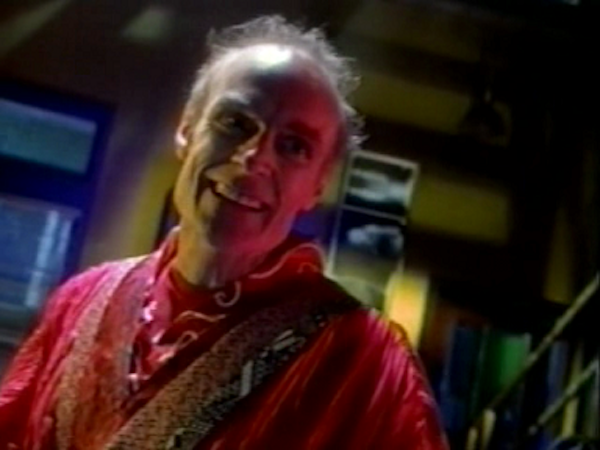
Okay, I am abject in my love for Matt Frewer, a love that goes back to the 1980s when he rocketed to prominence in Max Headroom. While he was best known for playing the loony title character, a computer-generated verbal scat artist, Frewer also played the male lead, Edison Carter, and did so quite well. Those two roles encapsulated the best and worst of Frewer’s career going forward, though. When he’s simply allowed to act, he’s superb, from his award-winning turn as a serial killer on DaVinci’s Inquest to his sleazy sinister role as a corrupt cop in Intelligence to his recurring role on Orphan Black as Dr. Leekie. When asked to be over the top and loopy, à la Headroom, it almost always ends badly. Either he’s so absurd as to be pathetic (see his awful Sherlock Holmes in several TV movies) or doing either a second-rate Robin Williams or a second-rate Jim Carrey.
It’s that last that he’s doing as Tresh, as you feel like they wanted Carrey for the role but couldn’t actually afford him, so they asked Frewer to impersonate him. It’s a terrible impersonation, and a terrible performance. All nuance is gone, and it’s impossible to take Tresh seriously.
The movie also is just confusing in terms of world-building. The kids are trained at the Xavier School, but there’s no mention of Charles Xavier or the X-Men (beyond sighting an X-Men video game in the arcade where Jubilee’s powers are outed, which is cute). Why not just have it be at the Massachusetts Academy and avoid the baggage associated with the Xavier name? There’s a Mutant Registration Act and unregistered mutants are sent to camp (as explained by a cop played by Garry Chalk, whom we just saw in Nick Fury, Agent of S.H.I.E.L.D.), but we get very little context for the history here. And there’s an inexplicable obsession with the dream dimension, which is more Doctor Strange than X-books.
Frewer’s goofiness, Ratchford’s comedy accent, Jubilee’s whitewashing, and the simply dreadful acting by Bumper Robinson and Randall Slavin as Mondo and Refrax undermine the actually-very-good work done by Finola Hughes as Frost (despite the aggressive fakeness of the blonde wig on the brunette Hughes), Amarilis as Monet, and Suzanne Davis as Buff. Between that and the plot silliness, GenX just doesn’t work.
And JLA isn’t any better, as these look more like DC cosplayers than they do the superheroes whose names they insist on using.
Next week, we’ll look at two attempts to bring Will Eisner’s The Spirit to the screen, the first another failed TV pilot, the other the first and last movie solely directed by Frank Miller.
Keith R.A. DeCandido has had a Patreon for two months now, and in that time has provided the following for patrons: two movie reviews (Star Wars: The Last Jedi and Proud Mary), nine TV reviews (Marvel’s Agents of S.H.I.E.L.D., MacGyver, The Librarians, Doctor Who, Major Crimes, Feed the Beast, Breakout Kings, The Alienist, and Black Lightning), weekly excerpts from my work-in-progress, first-draft chapters of that work-in progress (in both cases, my upcoming urban fantasy novel A Furnace Sealed), two exclusive vignettes featuring, respectively, my original characters Cassie Zukav and the Super City Police Department, and lots and lots of cat pictures! So sign up!










